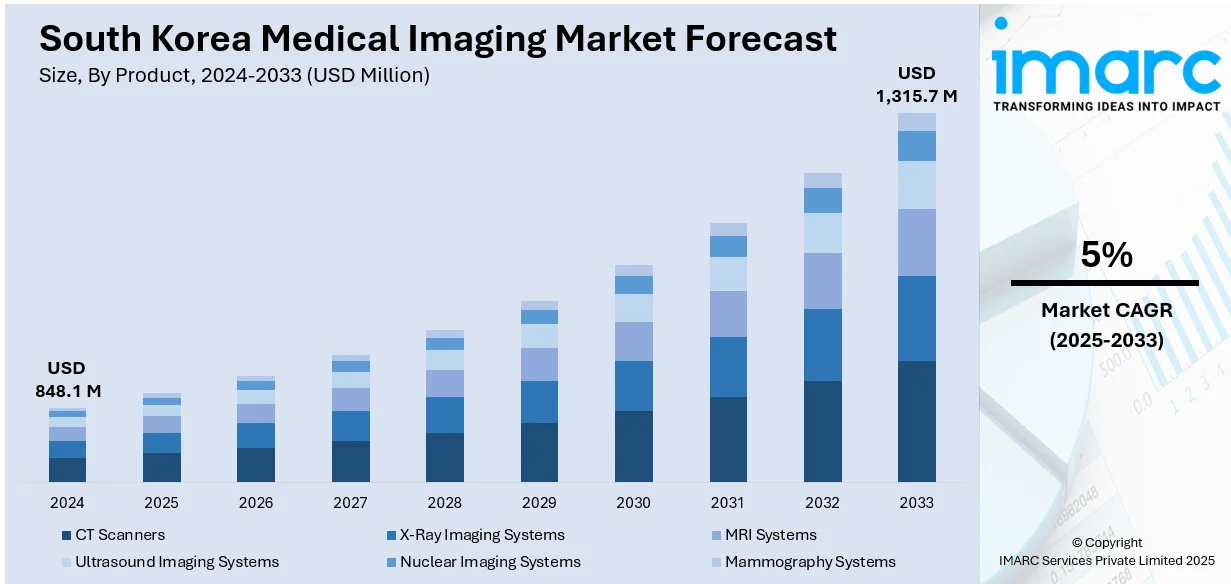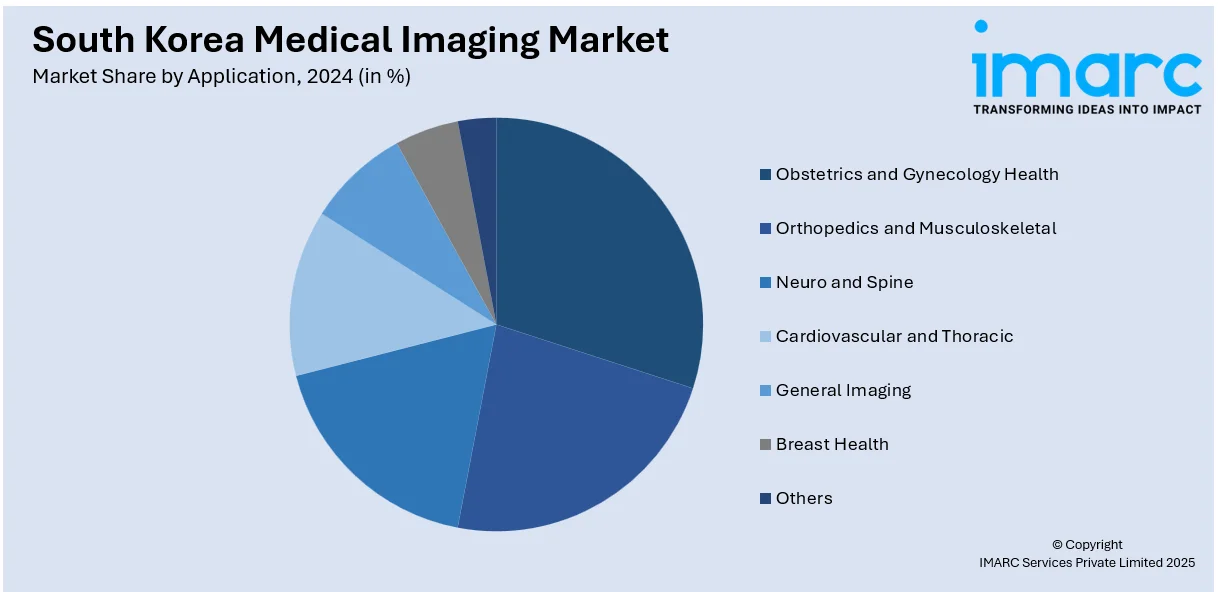
South Korea Medical Imaging Market Size, Share, Trends and Forecast by Product, Application, End User, and Region, 2025-2033
South Korea Medical Imaging Market Overview:
The South Korea medical imaging market size reached USD 848.1 Million in 2024. The market is projected to reach USD 1,315.7 Million by 2033, exhibiting a growth rate (CAGR) of 5% during 2025-2033. With an increasing number of individuals facing chronic conditions like cancer, heart diseases, diabetes, and neurological issues, the need for precise and timely diagnosis is rising. Besides this, the ongoing incorporation of artificial intelligence (AI), which aids in enhancing the speed and effectiveness of diagnostic processes, is contributing to the expansion of the South Korea medical imaging market share.
|
Report Attribute
|
Key Statistics
|
|---|---|
|
Base Year
|
2024 |
|
Forecast Years
|
2025-2033
|
|
Historical Years
|
2019-2024
|
| Market Size in 2024 | USD 848.1 Million |
| Market Forecast in 2033 | USD 1,315.7 Million |
| Market Growth Rate 2025-2033 | 5% |
South Korea Medical Imaging Market Trends:
Growing incidence of chronic conditions
Rising incidence of chronic conditions is positively influencing the market in South Korea. As more people in the country are suffering from long-term illnesses, such as cancer, cardiovascular diseases, diabetes, and neurological disorders, the demand for accurate and early diagnosis continues to grow. As per the NIH, 292,221 new cancer diagnoses and 83,770 cancer fatalities were anticipated in South Korea in 2024. Medical imaging technologies like magnetic resonance imaging (MRI), X-rays, and ultrasound play a vital role in detecting these diseases at early stages, enabling timely treatment and better health outcomes. In South Korea, lifestyle changes, aging population, and environmental factors are contributing to the increasing number of chronic disease cases, leading hospitals and clinics to invest more in advanced imaging equipment. These technologies help doctors monitor disease progression, plan treatments, and evaluate their effectiveness. Patients and healthcare providers rely heavily on imaging for routine check-ups and follow-ups, making it an essential part of chronic disease management. Additionally, public awareness about preventive healthcare is rising, encouraging people to undergo regular screening. The government and private sectors are also supporting the development and installation of modern diagnostic tools, ensuring wider access across the country. As chronic diseases are becoming more common, the need for precise, non-invasive diagnostic solutions continues to expand, supporting the South Korea medical imaging market growth.

To get more information on this market, Request Sample
Increasing AI usage
Rising AI integration is offering a favorable market outlook. As per the IMARC group, the South Korea AI market size was valued at USD 3.12 Billion in 2024. With AI-based tools, radiologists can quickly analyze large volumes of medical images, such as X-rays and MRIs, helping them detect abnormalities like tumors, fractures, and infections more accurately. AI aids in reducing human error and supporting early diagnosis, which is crucial for treating serious conditions, such as cancer and stroke. In South Korea, where healthcare technology adoption is strong, hospitals and clinics are using AI to support clinical decisions and refine patient outcomes. AI also helps streamline workflows by automating routine tasks like image sorting, comparison, and report generation, allowing doctors to focus more on patient care. Additionally, AI algorithms continue to improve over time through machine learning (ML), becoming even more precise in recognizing complex patterns. The integration of AI is also making imaging services faster and more accessible, especially in busy and understaffed medical facilities.
South Korea Medical Imaging Market Segmentation:
IMARC Group provides an analysis of the key trends in each segment of the market, along with forecasts at the country and regional levels for 2025-2033. Our report has categorized the market based on product, application, and end user.
Product Insights:
- CT Scanners
- X-Ray Imaging Systems
- MRI Systems
- Ultrasound Imaging Systems
- Nuclear Imaging Systems
- Mammography Systems
The report has provided a detailed breakup and analysis of the market based on the product. This includes CT scanners, X-ray imaging systems, MRI systems, ultrasound imaging systems, nuclear imaging systems, and mammography systems.
Application Insights:

- Obstetrics and Gynecology Health
- Orthopedics and Musculoskeletal
- Neuro and Spine
- Cardiovascular and Thoracic
- General Imaging
- Breast Health
- Others
A detailed breakup and analysis of the market based on the application have also been provided in the report. This includes obstetrics and gynecology health, orthopedics and musculoskeletal, neuro and spine, cardiovascular and thoracic, general imaging, breast health, and others.
End User Insights:
- Hospitals
- Diagnostic Centers
- Academic Institutes and Research Organizations
The report has provided a detailed breakup and analysis of the market based on the end user. This includes hospitals, diagnostic centers, and academic institutes and research organizations.
Regional Insights:
- Seoul Capital Area
- Yeongnam (Southeastern Region)
- Honam (Southwestern Region)
- Hoseo (Central Region)
- Others
The report has also provided a comprehensive analysis of all the major regional markets, which include Seoul Capital Area, Yeongnam (Southeastern Region), Honam (Southwestern Region), Hoseo (Central Region), and others.
Competitive Landscape:
The market research report has also provided a comprehensive analysis of the competitive landscape. Competitive analysis such as market structure, key player positioning, top winning strategies, competitive dashboard, and company evaluation quadrant has been covered in the report. Also, detailed profiles of all major companies have been provided.
South Korea Medical Imaging Market News:
- In January 2025, Seoul National University Hospital launched the 'Healthcare AI Research Institute' to explore and advance AI technologies aimed at speeding up medical innovations. This institute consisted of a data science center and a technology research center, engaging in studies across diverse areas, such as medical imaging, biometrics, and digital pathology.
- In October 2024, the Ministry of Health and Welfare in South Korea (MOHW) revealed seven projects under the ARPA-H initiative for advanced health research. Under one of the projects, Bangkok Dusit Medical Services in Thailand collaborated with Samsung Medison, a medical equipment manufacturer based in Seoul. As per their agreement, the two firms would work together on areas like medical imaging and AI.
South Korea Medical Imaging Market Report Coverage:
| Report Features | Details |
|---|---|
| Base Year of the Analysis | 2024 |
| Historical Period | 2019-2024 |
| Forecast Period | 2025-2033 |
| Units | Million USD |
| Scope of the Report | Exploration of Historical Trends and Market Outlook, Industry Catalysts and Challenges, Segment-Wise Historical and Future Market Assessment:
|
| Products Covered | CT Scanners, X-Ray Imaging Systems, MRI Systems, Ultrasound Imaging Systems, Nuclear Imaging Systems, Mammography Systems |
| Applications Covered | Obstetrics and Gynecology Health, Orthopedics and Musculoskeletal, Neuro and Spine, Cardiovascular and Thoracic, General Imaging, Breast Health, Others |
| End Users Covered | Hospitals, Diagnostic Centers, Academic Institutes and Research Organizations |
| Regions Covered | Seoul Capital Area, Yeongnam (Southeastern Region), Honam (Southwestern Region), Hoseo (Central Region), Others |
| Customization Scope | 10% Free Customization |
| Post-Sale Analyst Support | 10-12 Weeks |
| Delivery Format | PDF and Excel through Email (We can also provide the editable version of the report in PPT/Word format on special request) |
Key Questions Answered in This Report:
- How has the South Korea medical imaging market performed so far and how will it perform in the coming years?
- What is the breakup of the South Korea medical imaging market on the basis of product?
- What is the breakup of the South Korea medical imaging market on the basis of application?
- What is the breakup of the South Korea medical imaging market on the basis of end user?
- What is the breakup of the South Korea medical imaging market on the basis of region?
- What are the various stages in the value chain of the South Korea medical imaging market?
- What are the key driving factors and challenges in the South Korea medical imaging market?
- What is the structure of the South Korea medical imaging market and who are the key players?
- What is the degree of competition in the South Korea medical imaging market?
Key Benefits for Stakeholders:
- IMARC’s industry report offers a comprehensive quantitative analysis of various market segments, historical and current market trends, market forecasts, and dynamics of the South Korea medical imaging market from 2019-2033.
- The research report provides the latest information on the market drivers, challenges, and opportunities in the South Korea medical imaging market.
- Porter's five forces analysis assist stakeholders in assessing the impact of new entrants, competitive rivalry, supplier power, buyer power, and the threat of substitution. It helps stakeholders to analyze the level of competition within the South Korea medical imaging industry and its attractiveness.
- Competitive landscape allows stakeholders to understand their competitive environment and provides an insight into the current positions of key players in the market.
Need more help?
- Speak to our experienced analysts for insights on the current market scenarios.
- Include additional segments and countries to customize the report as per your requirement.
- Gain an unparalleled competitive advantage in your domain by understanding how to utilize the report and positively impacting your operations and revenue.
- For further assistance, please connect with our analysts.
 Request Customization
Request Customization
 Speak to an Analyst
Speak to an Analyst
 Request Brochure
Request Brochure
 Inquire Before Buying
Inquire Before Buying




.webp)




.webp)












